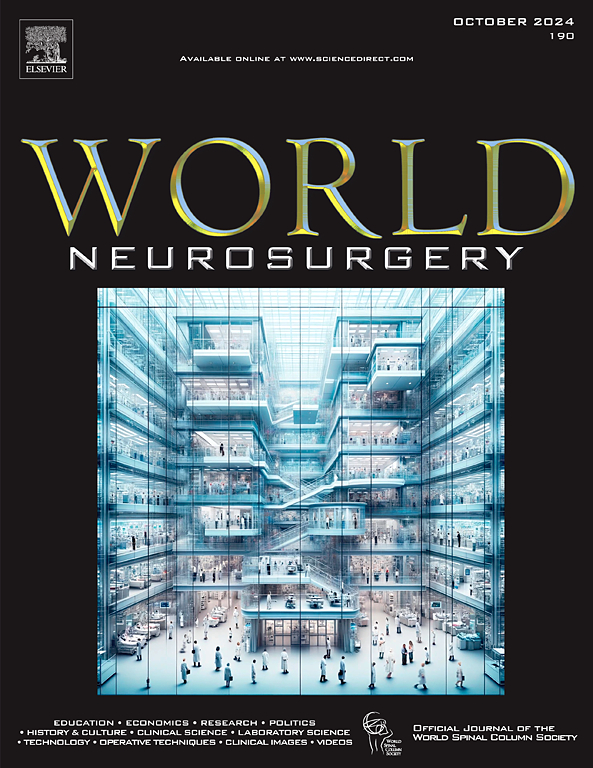利用融合成像对高级别胶质瘤的应变弹性成像和术前磁共振成像特征进行术中比较:一项试点研究。
IF 1.9
4区 医学
Q3 CLINICAL NEUROLOGY
引用次数: 0
摘要
目的比较术中超声显示的高级别胶质瘤(HGGs)实体部分和邻近健康脑实质的弹性成像模式与磁共振成像(MRI)特征。方法回顾性回顾2018年6月至12月期间手术的HGGs患者的临床记录和图像。融合图像用于比较术前钆增强 T1 加权 MRI/流体增强反转恢复图像(Gd-T1 MRI/FLAIR)与术中应变弹性成像(SE)。FLAIR/Gd-T1 MRI 图像用于定义:增强模式(无/整个病变/周边)和病变特征(原发性和继发性模式,进一步细分为实性/坏死性/囊性/浸润性)。HGG的SE模式分为均质/非均质,而病变的原发性和继发性模式则分为僵硬/中等/弹性。结果 18 名患者(男:女,11:7;平均年龄:53 岁)中有 14 名罹患胶质母细胞瘤(77.8%,GBMs)和 4 名罹患无弹性星形细胞瘤(22.2%,AAs)。在 T1-Gd MRI 和 FLAIR 图像上,GBM 通常向周围增强,并具有原发性坏死模式(分别为 78.6% 和 64.3%),而 AA 不增强,呈实性(均为 75%)。结论三种主要的 SE 模式定义了 HGGs 和邻近的健康脑实质。SE模式随HGG组织类型和Gd-T1 MRI/FLAIR特征而变化。本文章由计算机程序翻译,如有差异,请以英文原文为准。
Intraoperative Comparison Between Strain Elastography and Preoperative Magnetic Resonance Imaging Features in High-Grade Gliomas Using Fusion Imaging: A Pilot Study
Objective
To compare the elastographic patterns of high-grade gliomas (HGGs) solid portions and those of adjacent healthy brain parenchyma, on intraoperative ultrasound, with magnetic resonance image (MRI) characteristics.
Methods
Clinical records and images of HGGs patients, operated between June and December 2018, were retrospectively reviewed. Fusion images were used to compare preoperative gadolinium-enhanced T1-weighted MRI/fluid-attenuated inversion recovery images (Gd-T1 MRI/FLAIR) to intraoperative strain elastography (SE). FLAIR/Gd-T1 MRI images were used to define enhancement patterns (absent/whole lesion/peripheral) and lesions' characteristics (primary and secondary pattern, further subdivided in solid/necrotic/cystic/infiltrating). HGGs SE patterns were categorized as homogeneous/inhomogeneous, while lesions' primary and secondary patterns as stiff/intermediate/elastic. The SE motive of neighboring healthy brain parenchyma was defined similarly.
Results
Eighteen patients (M:F, 11:7; mean age: 53 years) harboring 14 glioblastomas (77.8%) and 4 anaplastic astrocytomas (22.2%) were compared. Glioblastomas typically enhanced peripherally and had a primary necrotic pattern (78.6% and 64.3%, respectively), while anaplastic astrocytomas did not enhance and were solid (75% both) at T1-Gd MRI and FLAIR images. At SE anaplastic astrocytomas had a homogeneous stiff primary pattern, whereas the majority of glioblastomas primary patterns were heterogeneous (85.7%) and intermediate (78.6%).
Conclusions
Three major SE patterns defined HGGs and adjacent healthy brain parenchyma. SE patterns varied according to HGG histotypes and Gd-T1 MRI/FLAIR characteristics.
求助全文
通过发布文献求助,成功后即可免费获取论文全文。
去求助
来源期刊

World neurosurgery
CLINICAL NEUROLOGY-SURGERY
CiteScore
3.90
自引率
15.00%
发文量
1765
审稿时长
47 days
期刊介绍:
World Neurosurgery has an open access mirror journal World Neurosurgery: X, sharing the same aims and scope, editorial team, submission system and rigorous peer review.
The journal''s mission is to:
-To provide a first-class international forum and a 2-way conduit for dialogue that is relevant to neurosurgeons and providers who care for neurosurgery patients. The categories of the exchanged information include clinical and basic science, as well as global information that provide social, political, educational, economic, cultural or societal insights and knowledge that are of significance and relevance to worldwide neurosurgery patient care.
-To act as a primary intellectual catalyst for the stimulation of creativity, the creation of new knowledge, and the enhancement of quality neurosurgical care worldwide.
-To provide a forum for communication that enriches the lives of all neurosurgeons and their colleagues; and, in so doing, enriches the lives of their patients.
Topics to be addressed in World Neurosurgery include: EDUCATION, ECONOMICS, RESEARCH, POLITICS, HISTORY, CULTURE, CLINICAL SCIENCE, LABORATORY SCIENCE, TECHNOLOGY, OPERATIVE TECHNIQUES, CLINICAL IMAGES, VIDEOS
 求助内容:
求助内容: 应助结果提醒方式:
应助结果提醒方式:


